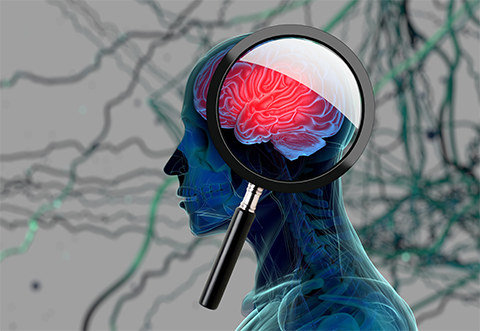From the journals: MCP
Targeting sANPEP in brain disease. A new insight for treating renal cancer. Read about articles on these topics recently published in the journal Molecular & Cellular Proteomics.
Targeting sANPEP in brain disease
Neuroinflammation, a response to cellular injury in the brain or spinal cord, helps the immune system and the brain communicate by recruiting cytokines and chemokines and also plays a role in neurodegenerative conditions such as Parkinson’s and Alzheimer’s diseases, multiple sclerosis and amyotrophic lateral sclerosis.

Complex integral activity among cells in the central nervous system, or CNS, including neurons and glia cells, causes neuroinflammation. The macroglial cells known as astrocytes, the most abundant and diverse nonneuronal cells in the CNS, are major regulators of neuroinflammation. Microglia, an integrative part of the CNS system, are nonneuronal cells that regulate the innate immune response of the brain. The crosstalk between microglia and astrocytes supports neuronal function and survival after acute CNS injury or disease, and this communication is maintained via secreted growth factors, cytokines, chemokines and innate-immunity mediators.
A recent Molecular & Cellular Proteomics article by Jong-Heon Kim and a team from Korea and the U.S. focuses on how the brain renin–angiotensin system, or RAS, regulates the astrocyte–microglia crosstalk by analysing the astrocyte secretome, which provides information about secreted proteins and their pathways.
The researchers identified a markedly elevated level of a soluble form of aminopeptidase N called sANPEP, a RAS component in the secretome, during neuroinflammation. They identified 322 proteins by proteomic analysis in astrocyte-conditioned medium following inflammatory stimulation. When they analyzed the proteins’ functional distribution, they found sANPEP was one of the upregulated proteins in RAS that is related to inflammation-associated pathways in activated astrocytes. They also found a significantly higher sANPEP level in the plasma of mice genetically altered for neuroinflammation than in unaltered mice.
This work helps identify sANPEP as a biomarker in disorders such as Alzheimer’s disease, because it is upregulated in the body fluid and human astrocytes in a neuroinflammation model. Its enzymatic activity to promote microglial stimulation indicates therapeutic potential as a drug target.
An insight for treating renal cancer
About 5% to 10% of all known cancer types are hereditary. These cancers, linked to gene mutations passed from parents to their offspring, are often difficult to treat.
Birt–Hogg–Dubé, or BHD, syndrome, a rare autosomal dominant inherited disorder, often precedes development of renal cell carcinoma, or RCC. In 2002, researchers identified a germline mutation in the folliculin gene, or FLCN, as a factor for BHD development. Since this discovery, multiple research groups have tried to understand how FLCN functions in RCC.
In a recently published Molecular & Cellular Proteomics article, Iris Glykofridis and a team in the Netherlands delved into the phosphorylated kinase pathway to understand how FLCN suppresses renal tumorigenesis. They investigated the role of FLCN in the cellular signaling pathway via protein and receptor phosphorylation by analyzing phosphoproteomic profiles of human renal tubular epithelial cells with and without FLCN. They identified specific tyrosine phosphorylation sites with markedly higher levels of phosphorylation in major receptor tyrosine kinases like EGFR and significant dephosphorylation in transcription factor EB phosphoserines upon FLCN loss.
The researchers analyzed the phosphoproteomic data and showed that FLCN loss has a clear effect on the phosphorylation of kinases and substrates within multiple biological pathways and may be important for the onset of oncogenic transformation of renal cells. The authors hope that understanding the FLCN-dependent phosphorylation pathway can open a new window to help design novel candidates for targeted therapies.
Enjoy reading ASBMB Today?
Become a member to receive the print edition four times a year and the digital edition monthly.
Learn moreGet the latest from ASBMB Today
Enter your email address, and we’ll send you a weekly email with recent articles, interviews and more.
Latest in Science
Science highlights or most popular articles

The science of staying strong
Muscles power every movement, but they also tell the story of aging itself. Scientists are uncovering how strength fades, why some species resist it and what lifestyle and molecular clues could help preserve muscle health for life.

Bacteriophage protein could make queso fresco safer
Researchers characterized the structure and function of PlyP100, a bacteriophage protein that shows promise as a food-safe antimicrobial for preventing Listeria monocytogenes growth in fresh cheeses.

Building the blueprint to block HIV
Wesley Sundquist will present his work on the HIV capsid and revolutionary drug, Lenacapavir, at the ASBMB Annual Meeting, March 7–10, in Maryland.

Gut microbes hijack cancer pathway in high-fat diets
Researchers at the Feinstein Institutes for Medical Research found that a high-fat diet increases ammonia-producing bacteria in the gut microbiome of mice, which in turn disrupts TGF-β signaling and promotes colorectal cancer.

Mapping fentanyl’s cellular footprint
Using a new imaging method, researchers at State University of New York at Buffalo traced fentanyl’s effects inside brain immune cells, revealing how the drug alters lipid droplets, pointing to new paths for addiction diagnostics.

Designing life’s building blocks with AI
Tanja Kortemme, a professor at the University of California, San Francisco, will discuss her research using computational biology to engineer proteins at the 2026 ASBMB Annual Meeting.

